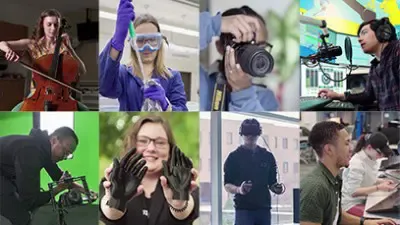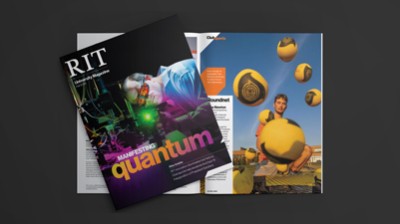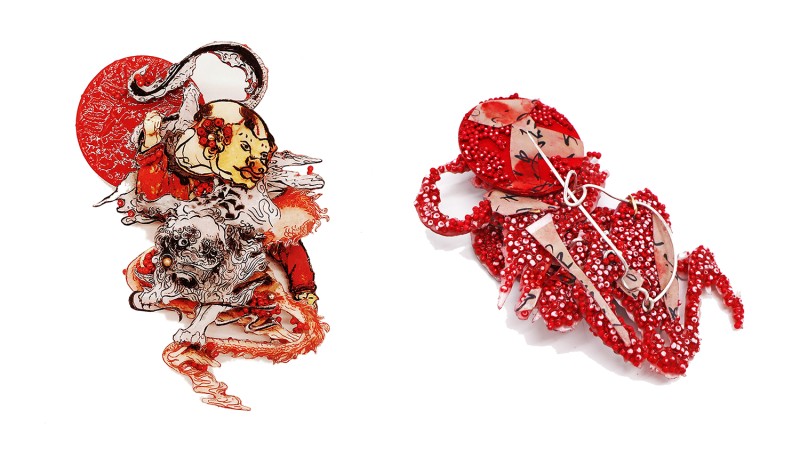Metals and Jewelry Design Master of Fine Arts Degree

Metals and Jewelry Design
Master of Fine Arts Degree
- RIT /
- Rochester Institute of Technology /
- Academics /
- Metals and Jewelry Design MFA
Overview for Metals and Jewelry Design MFA
The MFA in metals and jewelry design is a professional degree for practicing artists, craftspeople, or designers who desire to leave a lasting impression on their fields through devotion to their work and the high standards of discipline and artistic ideals. By immersing yourself in soldering, fabrication, stone setting, silversmithing, forging, and casting, this jewelry design degree will develop your knowledge and deepen your experience working with different theories and materials while you are challenged to think unconventionally in order to redefine industry standards.
RIT’s Jewelry Master’s Degree
The MFA in metals and jewelry design is generally a two-year, full-time degree that involves the presentation of a thesis. You will spend ample time creating work as you strengthen your metals techniques, design fundamentals, and personal expression while also exploring the process of critical analysis of your studio work. You will also gain deep knowledge in gallery administration and operations, and you'll participate in gallery and museum visitations and research.
Jewelry Design Courses
The jewelry design degree provides you with broad exposure to metalworking techniques, expands your knowledge of applied design, strengthens perceptual and philosophical concepts, and develops your individual modes of expression. This sequence leads to a master’s thesis, where you will work with RIT's gallery coordinators and curators to install and exhibit a final body of work you created over the course of the program. You will also learn the business side of art, including portfolio management, pricing, marketing strategies, and public relations–all skills needed by artists who embark on a professional career as a studio artist.
Studio Residency Program
The School for American Crafts offers a Studio Residency program for students in ceramics, furniture design, glass and metals and jewelry design. Residence positions are limited and are awarded after the review of all applicants’ portfolios, transcripts, and references. An interview is required. Accepted residents are required to register for one independent study credit during each semester of residence.
Accepted residents are expected to be present in their assigned studio during class hours and to contribute up to 10 hours of work per week in the main studio. These work hours are coordinated and overseen by the faculty in the resident's discipline. In exchange, the school will provide workspace, access to facilities, and supportive instruction. The resident is invited to participate in the full range of studio activities.
Participants may be those seeking additional studio experience prior to undergraduate or graduate study, early career professionals, or teachers on leave who wish to work again in an academic studio environment. The faculty in each discipline will make decisions concerning appropriate candidates.
Inquiries should be made to the Studio Residency Program, School for American Crafts, College of Art and Design, Rochester Institute of Technology, 73 Lomb Memorial Drive, Rochester, NY 14623-5603.
-
Affordable Now. Valuable for Life.
Earn your master’s degree without the full price tag. With Master Up you can receive a 30% tuition scholarship for an RIT master’s degree.
-
Meet us on-campus on February 19
Learn about the programs that interest you. Hear from program faculty, speak with current graduate students, and ask the questions that will help you get one step closer to your career goals.
Careers and Experiential Learning
Typical Job Titles
| Bench Jeweler | Curatorial Intern | Designer |
| Silversmith | Teaching Assistant |
Cooperative Education and Internships
What makes an RIT education exceptional? It’s the ability to complete relevant, hands-on career experience. At the graduate level, and paired with an advanced degree, cooperative education and internships give you the unparalleled credentials that truly set you apart. Learn more about graduate co-op and how it provides you with the career experience employers look for in their next top hires.
Co-ops and internships take your knowledge and turn it into know-how. An art and design co-op provides hands-on experience that enables you to apply your artistic capabilities in dynamic professional settings while you make valuable connections between classwork and real-world applications.
Cooperative education, internships, and other experiential learning opportunities are encouraged for graduate students in the MFA in metals and jewelry design.
Creative Industry Days
Connect with Design Industry Leaders
RIT’s Office of Career Services and Cooperative Education hosts Creative Industry Days, which connects students majoring in art, design, film and animation, photography, and select computing majors with companies, organizations, creative agencies, design firms, and more. Creative Industry Days are a series of events that allow you to network with company representatives and interview directly for open co-op and full-time employment positions.
Featured Work and Profiles
-
Public Sculpture
Juan Carlos Caballero-Perez, professor of Metals and Jewelry Design, created a near-12-foot sculpture for the Village of Fairport, N.Y.’s Kennelly Park, outside the public library. It was the...
Read More about Public Sculpture -
Visiting Artist: Corey Pemberton
Corey Pemberton spent three days embedded in the RIT College of Art and Design's creative community in February 2025, leading an artist talk, studio visits with MFA candidates, glassblowing demos, and...
Read More about Visiting Artist: Corey Pemberton -
Alumni Spotlight: Claudia Fava '14
Claudia (Owusu-Sampah) Fava has enjoyed an enriching career rising through the ranks at Tiffany & Co.
Read More about Alumni Spotlight: Claudia Fava '14 -
Embracing creativity and exploration
Alex Lobos, Gregory Halpern, Elizabeth Kronfield, Todd Jokl The College of Art and Design at RIT offers distinctive graduate degrees that combine the best of art, design, creativity and technology. Our diverse portfolio of graduate program offerings includes...
Read More about Embracing creativity and exploration -
Contemporary Jewelry Design
Drishti Bhandari The fifth episode of RIT City Art Space's Artist Short Sesh interview series features Drishti Bhandari '20 MFA (Metals and Jewelry Design). She often expands jewelry, making use of other...
Read More about Contemporary Jewelry Design -
History-inspired Jewelry
Hairuo Ding "Shan-hai Ching is a Chinese classic text and a compilation of mythic geography and beasts. Versions of the text may have existed since as early as the fourth century BC, but the present form was...
Read More about History-inspired Jewelry
Curriculum for 2025-2026 for Metals and Jewelry Design MFA
Current Students: See Curriculum Requirements
Students are also interested in
Admissions and Financial Aid
This program is available on-campus only.
| Offered | Admit Term(s) | Application Deadline | STEM Designated |
|---|---|---|---|
| Full‑time | Fall | February 1 priority deadline, rolling thereafter | No |
| Part‑time | Fall | Rolling | No |
Full-time study is 9+ semester credit hours. Part-time study is 1‑8 semester credit hours. International students requiring a visa to study at the RIT Rochester campus must study full‑time.
Application Details
To be considered for admission to the Metals and Jewelry Design MFA program, candidates must fulfill the following requirements:
- Complete an online graduate application.
- Submit copies of official transcript(s) (in English) of all previously completed undergraduate and graduate course work, including any transfer credit earned.
- Hold a baccalaureate degree (or US equivalent) from an accredited university or college. A minimum cumulative GPA of 3.0 (or equivalent) is recommended.
- Submit a current resume or curriculum vitae.
- Submit a personal statement of educational objectives.
- Submit two letters of recommendation.
- Entrance exam requirements: None
- Submit a portfolio. View portfolio requirements.
- Submit English language test scores (TOEFL, IELTS, PTE Academic, etc.), if required. Details are below.
English Language Test Scores
International applicants whose native language is not English must submit one of the following official English language test scores. Some international applicants may be considered for an English test requirement waiver.
Duolingo (DET): 120
IELTS: 6.5
LanguageCert Academic: 70
PTE Academic: 56
TOEFL: 79
International students below the minimum requirement may be considered for conditional admission. Deaf and hard-of-hearing test takers with significant hearing loss do not need to take the listening and speaking sections for the TOEFL and IELTS. Each program requires balanced sub-scores when determining an applicant’s need for additional English language courses.
How to Apply Start or Manage Your Application
Cost and Financial Aid
An RIT graduate degree is an investment with lifelong returns. Graduate tuition varies by degree, the number of credits taken per semester, and delivery method. View the general cost of attendance or estimate the cost of your graduate degree.
A combination of sources can help fund your graduate degree. Learn how to fund your degree
Crafts Scholarships
Students applying to the MFA programs in ceramics, glass, furniture design, and metals and jewelry design may apply for a competitive, full-tuition scholarship. Learn more about the crafts scholarships, including eligibility, application requirements, and deadlines to apply.
Accreditation
Related News
-
September 24, 2025
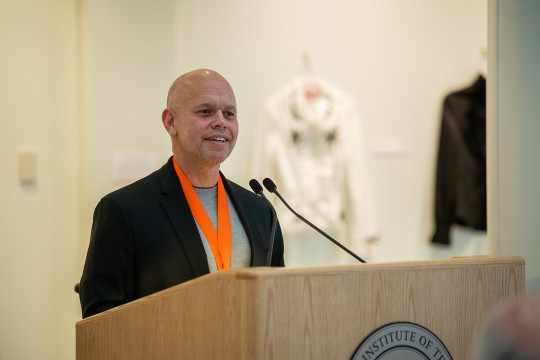
New School of Film and Animation director, faculty roles for 2025-26
Ricky Figueora taking over as the new director of RIT's School of Film and Animation headlines exciting promotions and additions to the College of Art and Design faculty.
-
November 12, 2024

RIT emerging artists sparkle at Milano Jewelry Week
Seven metals and jewelry design students and recent alumni exhibited their work during Milano Jewelry Week, with four of their pieces being selected as "winners" at the Talent Show event.
-
March 21, 2024
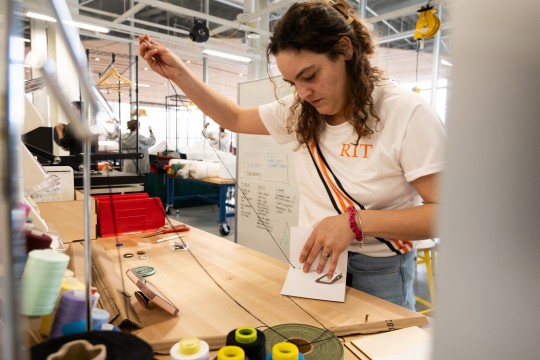
Innovation unleashed: students forge transdisciplinary projects at RIT's a2ru summit
Students leveraged the variety of makerspaces in RIT's brand-new SHED facility to create arts-integrative work responding to a theme of "Play."
Contact
- Bethany Iraci-McBane
- Assistant Director, Graduate Admissions
- Office of Graduate Admissions
- Enrollment Management
- 585‑475‑5235
- bimges@rit.edu
- Juan Carlos Caballero-Perez
- Professor, American Crafts
- School of Art
- College of Art and Design
- 585‑475‑2654
- jcc2390@rit.edu
School for American Crafts
